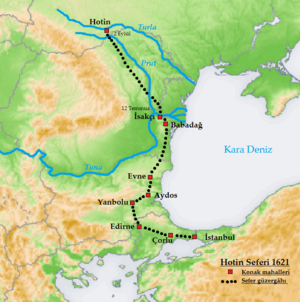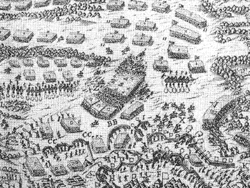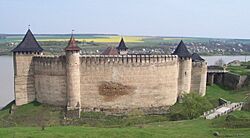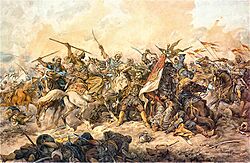Battle of Khotyn (1621) facts for kids
Quick facts for kids Battle of Khotyn (1621) |
|||||||
|---|---|---|---|---|---|---|---|
| Part of the Moldavian Magnate Wars and Polish–Ottoman War (1620–1621) | |||||||
 Battle of Chocim by Józef Brandt |
|||||||
|
|||||||
| Belligerents | |||||||
| Polish–Lithuanian Commonwealth Zaporozhian Cossacks |
Ottoman Empire Crimean Khanate Wallachia Moldavia |
||||||
| Commanders and leaders | |||||||
| Grand Hetman Jan Karol Chodkiewicz # Regimentarz Stanisław Lubomirski Crown Prince Władysław Vasa Petro Konashevych-Sahaidachny |
Sultan Osman II Grand Vizier Ohrili Hüseyin Pasha Khan Temir Canibek Giray |
||||||
| Strength | |||||||
|
25,000 Polish-Lithuanian troops:
|
120,000–160,000 Ottoman and Tatar, 13,000 Moldavian and Wallachian troops '34,825 Kapikulu (regular army)'~18,000 Janissary ~1,800 Cebeci ~1,300 artillery corps ~13,000 Kapikulu cavalry. |
||||||
| Casualties and losses | |||||||
| 14,000 killed | 40,000 killed | ||||||
The Battle of Khotyn (also called Battle of Chocim or Khotyn War) was a major fight that took place from September 2 to October 9, 1621. It was a mix of a siege and several battles. The battle was fought near Khotyn (in modern-day Ukraine).
On one side was an army from the Polish–Lithuanian Commonwealth and their Cossack allies. They were led by Grand Hetman of Lithuania Jan Karol Chodkiewicz. On the other side was a huge invading army from the Ottoman Empire, led by their young ruler, Sultan Osman II.
The Ottoman army was stopped by the strong defenses and the arrival of the first autumn snows. On October 9, the Ottomans gave up their siege because of the cold weather and heavy losses. The battle ended in a draw. This was shown in the peace treaty that followed. Sadly, Chodkiewicz died on September 24, 1621, shortly before the treaty was signed.
Contents
What's in a Name?
The town of Khotyn has been controlled by many different groups over time. Because of this, it has had many names. These include Chotyn or Choczim (especially in Polish).
Why the Battle Happened
Growing Tensions Between Empires
In the late 1500s and early 1600s, there was a lot of tension between the Polish–Lithuanian Commonwealth and the Ottoman Empire. Powerful nobles, called magnates, from the Commonwealth started getting involved in the affairs of Moldavia. Moldavia was a smaller state that was under the control of the Ottoman Empire.
Also, Ukrainian Cossacks, who were loosely connected to the Commonwealth, often raided Ottoman lands. This made the Ottomans very angry.
At the same time, a huge war called the Thirty Years' War was happening in Europe. The Commonwealth wasn't directly involved. However, the Polish King Sigismund III Vasa sent a group of skilled fighters called the Lisowczycy to help his allies, the Habsburgs, in Vienna. These fighters defeated a Transylvanian prince named George I Rákóczi in 1619. This prince then asked Sultan Osman II for help. The Sultan agreed and prepared a large army to invade the Commonwealth.
The 1620 Campaign
In September 1620, an Ottoman army defeated the Commonwealth army at the Battle of Cecora. They captured one Polish leader and killed another. After this, Tatar raiders attacked southern Poland. The fighting stopped for the winter, but both sides prepared to fight again in 1621.
The 1621 Campaign Begins
Ottoman Forces Gather
In April 1621, Sultan Osman II led a massive army of 120,000 to 160,000 soldiers. They marched from Constantinople towards the Polish border. Other leaders, like Khan Temir and Canibek Giray, joined the Ottomans with their Tatar forces. About a quarter of the Ottoman army came from their allied states, including Tatars, Moldavians, and Wallachians. This added up to about 13,000 troops. The Ottoman army also had around 66 heavy cannons.
Commonwealth Forces Prepare
After their defeat the year before, the Commonwealth's parliament (called the Sejm) agreed to raise taxes. This money was used to build a larger army and to recruit many Cossacks.
The main commander of the Polish-Lithuanian forces was Grand Lithuanian Hetman Jan Karol Chodkiewicz. In September 1621, he crossed the Dniester River with about 20,000 to 35,000 soldiers. Another 10,000 troops joined them, led by Prince Władysław Vasa, who would later become king. This army had about 30,000 soldiers, including cavalry and infantry. Their Cossack allies, led by ataman Petro Konashevych-Sahaidachny, had between 25,000 and 40,000 troops, mostly infantry, and about 22 cannons.
The Battle of Khotyn
Commonwealth's Battle Plan
The Polish-Lithuanian army arrived near Khotyn around August 24. They immediately began building strong defenses near the Khotyn Fortress. This blocked the path of the approaching Ottoman army.
The Commonwealth army used a common strategy when facing larger Ottoman forces. They built deep defenses with separate fortified areas in front of their main camp. These areas were designed to allow their cavalry to launch powerful counterattacks. Cavalry was very important for the Commonwealth, especially their skilled hussars and cossacks.
They built a semicircle of fortifications. The fortress was behind these defenses, and the Dniester River protected one side. The defensive line was split into three parts:
- The right side, led by Hetman Chodkiewicz.
- The center, led by Prince Władysław.
- The left side, led by Regimentarz Lubomirski.
Two smaller fortified camps were also set up in front of the main line: one for the Cossacks and one for the mercenary unit, the Lisowczycy.
Early Skirmishes
On August 27, a group of Cossack cavalry attacked the Ottoman forces. They caused a lot of damage and slowed the Ottomans down, but the Cossacks suffered heavy losses. On August 31, Ottoman cavalry attacked the Cossack forces outside their camp. The Ottomans tried to separate the Cossacks from the main Polish-Lithuanian army, but they failed. By September 2, the main Ottoman army had arrived, and the siege began the next day.
The Siege Begins
Ottoman Attacks
On September 2, the Ottomans tried to break into the Cossack camp, which was still being built. The Cossacks received help from the Polish-Lithuanian army and held their ground. On September 3, another Ottoman attack hit Lubomirski's part of the main defenses, but it was stopped.
Later that afternoon, a large Ottoman force attacked the Cossack camp again. This led to a very fierce fight. The Ottomans were pushed back. The Cossacks even chased them back to the Ottoman camp and returned with valuable loot. The next day, September 4, the Ottomans tried to take the Cossack camp again, but failed. A Commonwealth counterattack managed to destroy several Ottoman cannons. The experienced Commonwealth forces were able to hold off the Ottoman attacks. This was partly because the Ottoman army had too many cavalrymen and not enough skilled artillery soldiers.
On September 7, Ottoman troops attacked the Cossack camp four times, but they were always pushed back. At noon, Ottoman soldiers stormed the Commonwealth camp. The Janissaries (elite Ottoman soldiers) caught the Poles off guard, as they were resting. They attacked the right side of the Commonwealth army and broke into their defenses, killing about a hundred infantrymen. The Janissaries were eventually pushed back, but everyone expected another attack.
Commonwealth Fights Back
About 10,000 Ottomans prepared to attack. But then, Chodkiewicz himself led a counterattack with about 600 to 650 cavalrymen. The Ottoman cavalry could not stand against this charge and ran away in a disorganized mess. Chodkiewicz and his cavalry chased them all the way back to their camp. The Ottomans lost over 500 men, while the Commonwealth lost only 30. This attack caused heavy losses and greatly boosted the morale of the Commonwealth army.
On September 10, Chodkiewicz suggested a surprise night attack. An assault was planned for the night of September 12 to 13. However, heavy rain started just before the attack, and it had to be called off.
More Ottoman Attacks
After many costly and failed attacks in the first week, the Ottomans tried a different approach. They tried to win by cutting off the defenders' supplies and reinforcements, hoping they would run out of food and get sick. By September 14, a temporary bridge was built over the Dniester River. This allowed the Ottomans to stop the Commonwealth fortress from getting supplies or communicating with another fortress nearby. It also let the Ottomans move some of their cannons to the other side of the river and fire at the Commonwealth forces from behind. Another Ottoman attack on September 15 was also pushed back.
Cossack Raids
On the night of September 18, Cossacks bravely stormed into the Ottoman camp near the Dniester. The attack was successful, and the Ottomans suffered heavy losses. A similar attack happened on the night of September 21 to 22. This time, the Cossacks aimed for the lodging of Ohrili Hüseyin Pasha, an Ottoman commander, who was almost captured. These actions greatly boosted the morale of the Commonwealth troops.
Running Low on Supplies
Even though the defenders were getting weaker, the Ottomans could not break their spirit. Both sides were running low on food and supplies. On September 24, just a few days before the siege ended, the old Grand Hetman Chodkiewicz died from exhaustion and illness in the camp.
Chodkiewicz's second-in-command, Regimentarz Stanisław Lubomirski, took command of the Polish forces on September 23. On September 25, Lubomirski ordered his tired forces to move back to a smaller, shorter defensive line. The Ottomans tried another attack, hoping the defenders would be disorganized, but again, the attack failed. A final attack was stopped on September 28.
The late season, the loss of about 40,000 Ottoman soldiers, the general tiredness of the Ottoman army, and the fact that they were also running out of supplies forced Sultan Osman II to agree to talk about peace. This happened even though the Polish-Lithuanian forces were almost completely out of supplies.
What Happened After the Battle

A peace agreement, called the Treaty of Khotyn, was signed on October 9. This treaty showed that neither side had completely won the battle. Some parts of the treaty favored the Commonwealth, while others favored the Ottoman Empire. No land changed hands. The border between the Commonwealth and the Ottoman Empire remained the Dniester River, and the Commonwealth agreed that Moldavia was under Ottoman control. In the Commonwealth and among the Cossacks, stopping the huge Ottoman army was seen as a great victory.
Sultan Osman II was not happy with the battle's outcome. He blamed his elite soldiers, the janissaries, for the problems. Osman wanted to make the army more modern, but the Janissaries, who liked old traditions, were against his plans. This disagreement led to a rebellion of Janissaries in 1622. During this rebellion, Osman II was removed from power and killed.
The Commonwealth had already lost Grand Hetman Chodkiewicz during the battle. Soon after, they lost another important military leader, Hetman of Registered Cossacks Petro Konashevych-Sahaidachny. He could not recover from his battle injuries and died several months later.
How the Battle Was Remembered
The Battle of Khotyn was the biggest battle in the history of the Polish Commonwealth up to that time. It was celebrated as a great victory. One famous account of the battle is from Wacław Potocki's The Progress of the War of Chocim, written between 1669 and 1672.
On the Ottoman side, young Sultan Osman II publicly said that the battle was an Ottoman victory. When he returned to Constantinople on December 27, 1621, he had a victory parade. There were three days and nights of celebrations. However, the young Sultan was secretly very unhappy with the battle's result and how his Janissary soldiers behaved. He started trying to reform the Ottoman military. This attempt led to a revolt in Constantinople in May 1622. During this revolt, Sultan Osman II was removed from power and killed. He was only 17 years old. This revolt and the sad death of the young Sultan are often written about by Ottoman historians.
The Battle of Khotyn is remembered on the Tomb of the Unknown Soldier, Warsaw, with the inscription "CHOCIM 2 IX - 9 X 1621/10 - 11 XI 1673".





